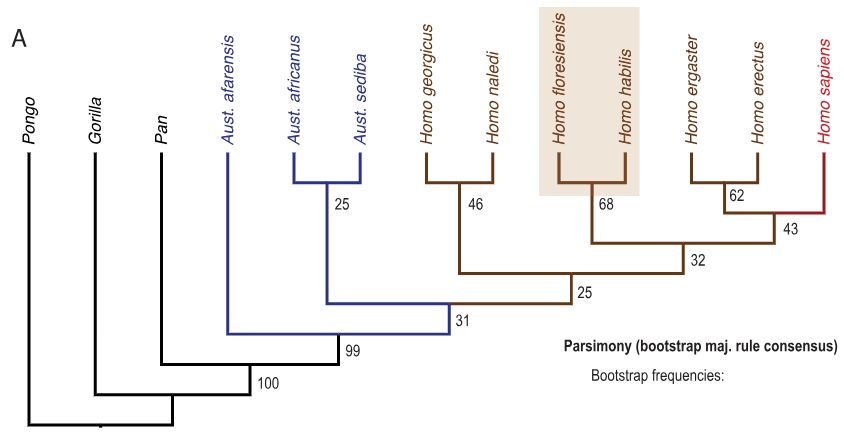PermeateFree said:
You are of course entitled to your opinion moll, but is it of comparative value to the scientists that have spent considerable time and effort to reach their conclusions. Are you an expert on human evolution, anatomy, etc?
I haven’t told you my opinion yet. All I’ve said so far it that I’m keeping an open mind.
Experts on human anatomy have three conflicting hypotheses, only one of which can be right. Even a cursory examination of the brain morphology of the inside of the skull suffices to discard the hydrocephalus hypothesis. That leaves the experts with two conflicting hypotheses. Which is correct?
PS, we’ve seen conflicts like this between experts on human ancestry dozens of times before, there’s even a chapter about it in a book I recently bought.
So let’s give some thought to what is and isn’t primitive. Certain cranial characteristics are linked to diet. Large molars, smaller canines, stronger jaw, larger muscle attachment regions and smaller brain size are all connected to a vegetarian lifestyle. So these need not be primitive if diet changes. Smaller overall body size, in proportion, need not be primitive. Changes in limb length, in proportion but separate from body size, need not be primitive.
I’m inclined to think that the shape of the brain inside the skull is a good indicator.
So let’s look, at these 133 measurements.
Specimens used:
2 specimens of Homo floresiensis. Cranium, cranial part, postcranium, mandible, lower dentition
19 specimens of Homo erectus. Similar parts.
That’s a good collection.
Looking at the table of 133 measurements, that looks like a good collection, too. But I note that some of these are ratios and some are linear measurements. Those characteristics that are ratios are going to be more reliable indicators than those that are linear measurements.
> Bayesian analyses were performed on datasets A and B using MrBayes 3.2.5 (Ronquist et al., 2012). It should be noted, however,that MrBayes treats polymorphic cells in a phylogenetic matrix as totally unknown to improve computational efficiency; thus, the results for Dataset B (variable taxa coded as polymorphic) are potentially highly conservative.
I’m not sure what they mean by “highly conservative” but the paper is right in treating parsimony ans more reliable, it’s far better to check whether variable taxa should be regarded as polymorphic.
> We employed the appropriate evolutionary model selected by stepping-stone analysis
I need to read up on stepping-stone analysis.
> Finally, analyses were also performed after recoding H. habilis by excluding equivocally-attributed postcranial remains
Hmm. Let’s look at Figure 1.

That means that according to their analysis there’s a 68% chance that the closest species is Homo habilis, a 32% chance that it is not the unique closest species. From Figure 2, where the intraspecific variability is coded as polymorphism, there’s only a 54% chance that the closest species is Homo habilis.
With such low probabilities, it’s good to retain an open mind.
Common factors with H habilis are 15 of the 133 original characteristics:
- External occipital protuberance prominent
- Fissure between mastoid process and petrous crest of tympanic present
- Greatest axis of auditory meatus from inferior margin to superior margin slopes posteriorly
- Supraorbital sulcus present
- Metopic prominence at least variably present
- Temporal line not directly linked with supramastoid crest
- Inferior transverse torus prominent
- Digastric fossa absent
- Contact between metaconid and hypoconid on M2 is Y-shaped
- Lower premolar mesiobuccal grooves present
- Lower premolar distobuccal grooves present
- Lower premolar mesiolingual grooves present
- P3 mesiolingual beak present
- Pilaster on femur shaft at least weakly defined and absent, or absent entirely
- Humerofemoral index medium
(Is there an anatomist in the house?)
One thing I do see, is that the 15 characteristics linking to habilis are all proportional measurements, not absolute measurements. I approve of that.
There are only six common factors that link erectus, ergaster and sapiens, because many features are not present in the erectus specimens we have. These are:
- Medial incursion of the superior temporal lines at coronal suture: inflection at least variably present
- Canine juga absent
- Obelionic depression at least variably present
- Genioglossal fossa shallow or absent
- P3 talonid height in relation to protoconid is moderate
- P3 occlusal crown outline along axis of tooth row at least variably present
If I leave off the three “variably present” and the “moderate” criteria, there are only two common factors left between erectus, ergaster and sapiens. Too small a set to make a decision on.
Their Figure 1 confirms this. It only has a 43% of 62% = a 27% chance of being correct.